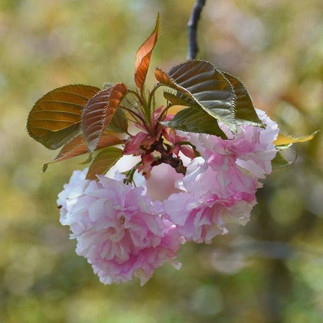Sayen Gardens - Part 3 Other Flowering Shrubs, Flowers, and Trees
- Meghan Hirst

- May 13, 2021
- 4 min read
Updated: Jun 26, 2021
Some of the other beautiful plant species that grow here!
Columbines, Pieris japonica, Kanzan Cherry, Star Magnolia, Lilacs, Black-Eyed Susans. Photos by Nature Photographer Pam Hirst at PKH Photography. Writing by Freelance Content Writer and Travel Blogger Meghan Hirst at Meghan Hirst, Writer.
"Flowers are the music of the ground. From earth's lips spoken without sound."
-Edwin Curran
If you missed our first post about the plants at Sayen Gardens, you can view it here: https://meghanhirst27.wixsite.com/my-site/post/sayen-gardens-part-2-azaleas.
An amusing thing happened when my mom was sending me these photos. She asked which plants are my favorite and I replied the columbines, Pieris japonica, and Kanzan cherry. It turns out that she gravitates toward the opposite ones: the star magnolia, lilacs, and black-eyed Susans XD It is apparent that I prefer the modern plants and she prefers the traditional ones.
My mom has a life story attached to lilacs and would like to do a special post about it on our Facebook page. Look out for it after this post is announced. If you have not checked out our page yet, follow the social media icon at the bottom of our website. We look forward to seeing you there!
Columbines (aka granny's bonnet and crowfoot) are one of the most unique flowers that my mom and I have ever seen :O They stemmed from (lol XD) Europe and North America, but can be found in Japan and China as well. They are evergreen and spring up in a variety of colors and can be multi-colored. More than seventy species exist. These flowers are super sturdy even though they do not appear to be—they can survive droughts. If you live in an arid climate and are looking to start a garden/add to it, columbines would be an ideal choice.
Pieris japonica evergreen shrubs are also called Japanese Pieris, Japanese andromeda, lily-of-the-valley, and asebi. Pieris is derived from Pierides, who is a goddess of science and the arts (Muse) from Greek mythology. Japonica means "of/from Japan" in Greek (I am having a happy nerd moment learning about the semantics XD) Pieris japonica originated in Taiwan, China, and the Japanese mountains of Kyushu, Shikoku, and Honshu. One variety is called 'Mountain Fire' due to its fiery red leaves :O These shrubs grow in white and different shades of pink. If you are thinking about planting some, do not be concerned about sunlight because they can thrive in shadowy areas.
Kanzan, Kwanzan, Sekiyama, or sakura are deciduous cherry blossom trees that came from Japan, China, and Korea. They are pink when they bloom in spring then turn yellow in autumn. Despite their name, they do not produce fruit. These trees represent profound concepts in Japan: renewal and the transient nature of all life. This is due to the beauty of the sprouting buds and the fact that they only live for up to forty years. I recently watched a fascinating cultural video that showed footage from a cherry blossom festival in Japan. These festivals are held every year in April. Families and friends sit on blankets under the trees and have feasts. Some of the foods consist of blossom treats like milk pudding, cookies, and dango (sweetened rice flour dumplings). The blossoms have a subtle floral taste. The traditional name for the cherry blossom viewing itself–or any other flower viewing–is hanami.
The star magnolia (aka Magnolia stellata) is another Japanese species :D Oddly, these are classified as both shrubs and trees. Like Pieris japonica, they are white and pink. However, they are deciduous like Kanzan. One type of star magnolia has cool name: 'Royal Star'. This specific type sprouts around ten days earlier than regular magnolias.
Lilacs, or Syringa vulgaris, are deciduous shrubs that grow in white, yellow, pink, and purple. They came from Europe and Asia and are famous for their strong pleasant scent. My mom and I can still smell them through our masks! If you need to plant flowers that do better in the shade, placing lilacs next to them is a great tactic because these shrubs can grow up to thirty feet tall :O
Black-eyed Susans are also known as Rudbeckia hirta. They originated in North America and are one of the most well-known wildflower species here. They sprout in yellow, orange, and red. There is an interesting piece of history behind their name. It is surmised to be derived from an Old English poem that was written after the Elizabethan era. A woman who is referred to as "black-eyed Susan" says an emotional goodbye to her partner, a sailor named William, before he goes off to fight. Although it seems like black-eyed Susans got their name during this time period, they were around long before that. Native Americans used them for medicinal purposes. These flowers can live through droughts like columbines and can hold their own against heat and humidity. The photo of the black-eyed Susans that we are displaying in this post is one of my mom's best photos. She got eighth place in a Photocrowd contest. That was her highest win yet! :D
My mom and I hope you loved learning about/learning more about these flowering shrubs, flowers, and trees! If you want to know more about each species, do a google search. We only presented a fraction of the information that is out there. Stay tuned for the last part of Sayen Gardens where we will discuss the scenery in all four seasons in this location!
Which flowering shrub, flower, or tree depicted here do you favor?
















Comments